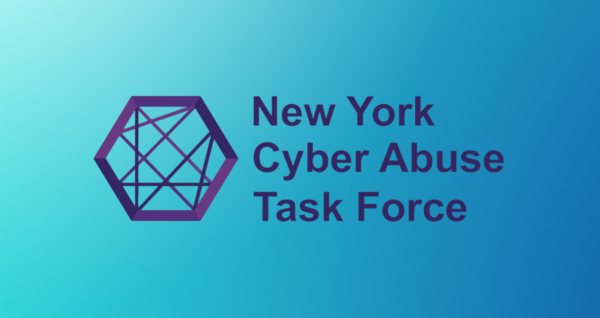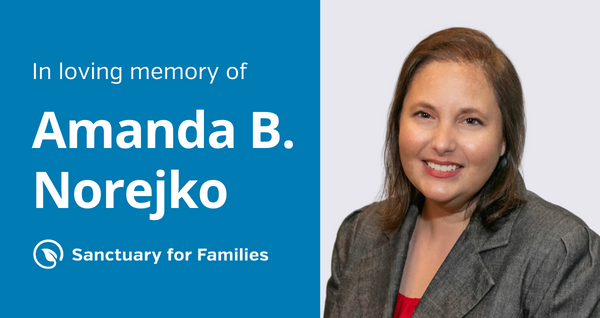At this year’s Above & Beyond Awards, Sanctuary for Families is thrilled to honor Susan M. Cordaro, Deputy Pro Bono Counsel at Simpson Thacher & Bartlett LLP.
At this year’s Above & Beyond Awards, Sanctuary for Families is honoring Susan M. Cordaro, Deputy Pro Bono Counsel at Simpson Thacher & Bartlett LLP, for her outstanding dedication to helping survivors of gender-based violence and her work with numerous pro bono clients within Sanctuary’s Family Law Project and Matrimonial/Economic Justice Project.
For several years, Susan Cordaro has provided compassionate and skilled legal services to dozens of Sanctuary’s clients, delivering trauma-informed legal advice and representation in a range of cases, including appeals, asylum matters, divorces, custody/visitation cases, and orders of protection.
In addition to representing survivors, Susan leads and coordinates the Sanctuary/Simpson Thacher Family Law Screening Project in the Bronx Family Justice Center (Bronx FJC). For the last several years, Simpson Thacher attorneys have participated in Bronx FJC legal screenings conducted by Sanctuary attorneys, during which Simpson Thacher volunteers take detailed notes and then assist with any follow-up pro se assistance or research that the client may need, including drafting pro se petitions. This Project has enhanced our ability to more significantly serve Bronx FJC clients and meet their needs. Susan’s leadership and commitment to the Project has been invaluable to its success. Susan doesn’t just manage the Project for Simpson Thacher, she also supervises, provides advice, and has herself volunteered to participate in many legal screenings. Susan has become so adept at understanding survivor legal needs that she has even started conducting legal screenings on her own.
Karla George, Associate Program Director of Sanctuary’s Bronx FJC Family Law Project, said,
“Susan’s leadership in supervising our screening clinic in the Bronx with Simpson Thacher has been outstanding and life-changing, supplementing our staff resources and enabling us to provide more and deeper services to clients. I have personally enjoyed this collaboration with Susan, who always shows up with positive energy and cares deeply about our clients. We are eternally grateful to Susan and her pro bono team!”
In addition to her work with the screening project, Susan was also nominated for an Above & Beyond award this year for providing direct representation to multiple survivors. She has been indispensable in many cases, and in particular on appeals from Family Court decisions. Two recent cases provide examples of Susan’s critical work with survivors and their families: a grandparent visitation petition won on appeal after the original petition had been dismissed, and a successful appeal from a final order of custody granted to our client.
In the first case, which Susan staffed in the Appellate Division along with Simpson Thacher former associate Sara L. Estela, Litigation Counsel Sarah Phillips, and Retired Partner Mary Beth Forshaw, and then subsequently in the Family Court with associates Isabel R. Mattson, Lauren Smith, and former associate Rebecca Sussman, the court had originally determined that the grandmother of one of Sanctuary’s clients did not have standing to seek visitation with her grandson. This was particularly troubling given that the grandmother had helped to care for the child during the early years of his life when his father was either not present or was present but extremely abusive toward the child’s mother and neglectful toward his son. Despite this and as a result of a long and unsettling legal history, the father has full custody over the child while our client tragically lost her green card and is unable to re-enter the US to visit her son. Given these circumstances, being able to guarantee the grandmother’s continued presence in the child’s life was critical to his well-being. After two years, an appellate victory, numerous Family Court appearances after remand, and the commencement of a trial, Susan and the team were able to settle the case on very favorable terms.
Sanctuary Senior Staff Attorney Ruchama Cohen, who worked with Susan on this challenging case, said,
“I’m thrilled to see Susan Cordaro recognized for her exceptional work on behalf of our clients. Her skill in the courtroom is matched only by her compassion for her clients. Susan has been a long-time mentor for me personally, and she is an inspiration to those of us at Sanctuary who are privileged to work with her.”
On the second case, Susan won a successful appeal from a Final Order of Custody granted to a survivor in Bronx Family Court after an extensive, highly contested trial, in which the abusive father was granted only email contact with the child, with no visitation. In response to questioning from the bench during oral argument, Susan strategically suggested a tweak to the Order that was adopted by the Appellate Division and, therefore, saved the Order from being struck or remanded for additional hearings.
Senior Program Director of the Family Law Project, Jennifer Friedman, noted,
“This case was extremely hard fought, over many years. … This client and her daughter were severely traumatized by the father, but also by the case. If this case had been remanded, it would have been devastating to them both.”
Susan’s brilliant brief and litigation skills enabled the avoidance of an otherwise catastrophic outcome for this family. On working with Susan in general, Jennifer said,
“Susan is always available, always endeavors to assist us when we ask; always has a positive attitude, and is delightful to work with. Her commitment to our clients and our work is amazing!”
Pro Bono Counsel and Director at Simpson Thacher, Harlene Katzman, concluded,
“We are incredibly proud of Susan’s leadership of the family law appeals that anchor her pro bono work with Sanctuary for Families. Through this project, Susan provides invaluable hands-on mentoring and guidance to litigation associates who may be writing an appellate brief and arguing in court for the very first time. Susan’s contributions at Simpson Thacher extend far beyond her family law practice. She is a critical part of our pro bono team, sharing her wisdom, experience, strategic thinking and creative solutions to problems big and small. Congratulations Susan on this very well-deserved honor!”
We are deeply grateful to Susan for the incredible time and energy she has put towards serving survivors of gender-based violence.
Join us at our Above & Beyond Awards Ceremony on October 25, 2023, as we honor Simpson Thacher & Bartlett’s outstanding pro bono work.
PURCHASE TICKETS
DONATE TODAY



